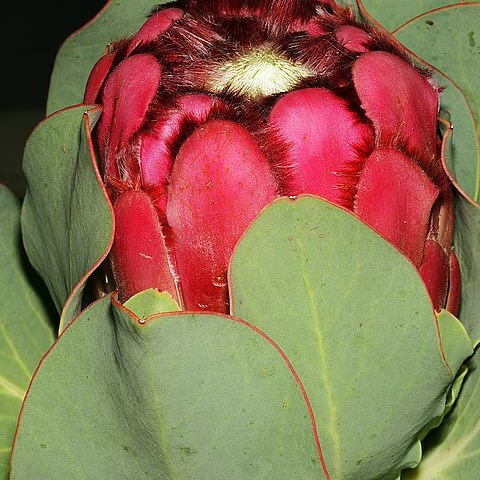A stocky rounded shrub to 2 m in height, 3 m in diam., with a single main trunk. Stems stout, 10-12 mm in diam., glabrous. Leaves ascending, sessile, oval, obovate to very broadly obovate, 80-130 mm long, 30-85 mm wide, heavily coriaceous, glabrous, slightly glaucescent, apices obtuse to rounded. Inflorescences broadly oblong, 100-140 mm long, 60-80 mm wide. Involucral receptacle convex, 25-30 mm wide, 10 mm high. Involucral bracts 7-8 seriate, outer surface glabrescent to sparsely and minutely adpressed-puberulous; outer series imbricate, broadly ovate, 15-25 mm long, 15-20 mm wide, margins minutely ciliate; inner series oblong-spathulate, 70-80 mm long, 15-20 mm wide, apices spathulate, rounded and incurved, heavily bearded with a thick 10-15 mm long fringe of white, purple or mixed purple and white trichomes. Perianth slightly adaxially curved, 75-85 mm long; tube region 10 mm long, quadrangular and ribbed, glabrous proximally becoming tawny-villous distally; claws slender, tawny-villous, becoming filiform distally; limbs 20-25 mm long, linear-subulate prolonged into 10/15 mm long subulate awns, the median adaxial awn shorter than the 2 lateral adaxial awns, limbs and awns glabrous except for long bristles on the abaxial surface. Style slightly adaxially arcuate, 65-75 mm long glabrous, ancipitous. Pollen presenter linear-filiform, clearly differentiated from style and geniculate at junction, apex minutely capitellate and adaxially curved. Ovary obconic, 5 mm long, covered with long tawny trichomes. Hypogynous scales ovate acute, 1.5 mm long. Flowering takes place between September and January. Flowering time, however, is largely dependent on locality and microclimate, although the peak of the season is reached in December and January.
More
Shrub, erect, single trunk, 1.3-2.0 m high. Leaves sessile, curved upwards, oval to broadly obovate, 80-130 x 30-85 mm, rounded, margins wavy, glaucous, coriaceous, glabrous. Flower head broadly oblong, 100-140 x 60-80 mm. Involucral bracts 7-or 8-seriate, coral-pink, glabrous to downy, imbricate; outer series ovate, rounded, 15-25 x 15-20 mm, margins hairy; inner series oblong-spathulate, rounded, 70-80 x 15-20 mm, tip curved inwards with white to purple beard 10-15 mm long. Flowers 75-85 mm long, tube 10 mm long, awns 10-15 mm long; style 65-75 mm long, slightly curved; pollen presenter thread-like, curved. Flowering time Dec., Jan.
Rounded shrub to 2 m. Leaves ovate to obovate, glaucous. Flower heads oblong, 100-140 x ± 70 mm, involucral bracts brick-red, glabrous or shortly hairy, white-to purple-bearded, style ± 65 mm long.


